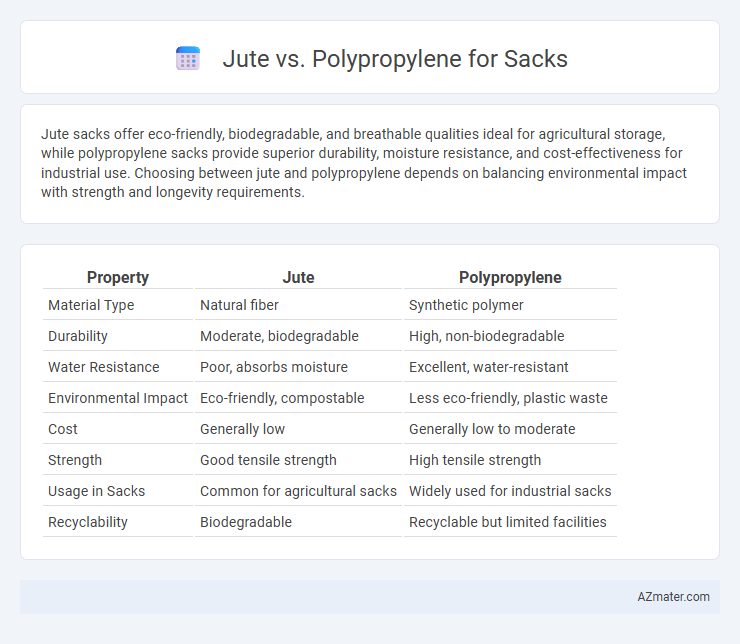Jute sacks offer eco-friendly, biodegradable, and breathable qualities ideal for agricultural storage, while polypropylene sacks provide superior durability, moisture resistance, and cost-effectiveness for industrial use. Choosing between jute and polypropylene depends on balancing environmental impact with strength and longevity requirements.
Table of Comparison
| Property | Jute | Polypropylene |
|---|---|---|
| Material Type | Natural fiber | Synthetic polymer |
| Durability | Moderate, biodegradable | High, non-biodegradable |
| Water Resistance | Poor, absorbs moisture | Excellent, water-resistant |
| Environmental Impact | Eco-friendly, compostable | Less eco-friendly, plastic waste |
| Cost | Generally low | Generally low to moderate |
| Strength | Good tensile strength | High tensile strength |
| Usage in Sacks | Common for agricultural sacks | Widely used for industrial sacks |
| Recyclability | Biodegradable | Recyclable but limited facilities |
Introduction to Jute and Polypropylene Sacks
Jute sacks are made from natural fibers derived from the jute plant, known for their biodegradability, breathability, and strength, making them ideal for storing agricultural products. Polypropylene sacks, composed of synthetic polymer strands, offer durability, moisture resistance, and cost-effectiveness, widely used in industrial and commercial sectors. Both materials serve specific storage needs, with jute emphasizing eco-friendliness and polypropylene focusing on resilience and moisture protection.
Material Composition: Jute vs Polypropylene
Jute sacks are made from natural fibers derived from the jute plant, offering biodegradability and excellent breathability, making them ideal for agricultural products. Polypropylene sacks consist of synthetic polymers, providing superior strength, moisture resistance, and durability for varied industrial applications. The choice between jute and polypropylene depends on environmental concerns and specific packaging needs.
Strength and Durability Comparison
Jute sacks offer natural fiber strength with moderate tensile resistance, making them biodegradable and eco-friendly but less durable under prolonged moisture exposure. Polypropylene sacks provide superior tensile strength and resistance to wear, moisture, and chemicals, ensuring extended durability and reuse in various industrial applications. Choosing between the two depends on balancing environmental impact with performance requirements, as polypropylene excels in durability while jute maintains sustainability benefits.
Environmental Impact and Sustainability
Jute sacks are biodegradable and renewable, significantly reducing environmental pollution compared to polypropylene sacks, which are derived from non-renewable petroleum and contribute to microplastic pollution. The cultivation of jute supports carbon sequestration and soil health, enhancing sustainability by decreasing carbon footprints. Polypropylene sacks, although durable and recyclable, pose long-term ecological risks due to their resistance to degradation and potential to release toxins during incineration.
Cost Analysis: Jute Sacks vs Polypropylene Sacks
Jute sacks typically incur higher initial costs due to natural fiber processing and lower production scale compared to polypropylene sacks, which benefit from mass polymer manufacturing and lower raw material expenses. Polypropylene sacks offer cost advantages in durability and moisture resistance, reducing replacement frequency and overall expense in long-term agricultural or industrial use. Evaluating total lifecycle costs often reveals polypropylene sacks as more economically viable for bulk storage and transport despite jute's eco-friendly appeal.
Moisture Resistance and Breathability
Jute sacks offer superior breathability due to their natural fiber structure, allowing moisture to escape and reducing the risk of mold and spoilage in stored goods. Polypropylene sacks provide enhanced moisture resistance, making them ideal for wet or humid environments by preventing water ingress and protecting contents from dampness. Choosing between jute and polypropylene sacks depends on prioritizing breathability for fresh produce or moisture resistance for durable, weather-exposed applications.
Common Applications and Industries
Jute sacks are widely used in agriculture for packaging grains, seeds, and produce due to their natural biodegradability and breathability, making them ideal for storing potatoes, coffee beans, and onions. Polypropylene sacks dominate the construction and industrial sectors, favored for their durability, moisture resistance, and strength in transporting cement, chemicals, and fertilizers. Both materials serve key roles in logistics and bulk material handling but are selected based on industry-specific requirements for environmental impact and load-bearing capacity.
Reusability and Biodegradability
Jute sacks offer superior biodegradability due to their natural fiber composition, breaking down effortlessly within months under composting conditions, making them environmentally sustainable. Polypropylene sacks, while highly durable and reusable multiple times thanks to their synthetic, water-resistant properties, pose challenges for biodegradability, as they can take hundreds of years to decompose and often contribute to microplastic pollution. Choosing jute enhances ecological benefits through natural decomposition, whereas polypropylene provides extended reusability but with significant environmental persistence.
Aesthetic and Branding Possibilities
Jute sacks offer a natural, rustic aesthetic with a coarse texture that enhances eco-friendly branding and appeals to sustainability-conscious consumers. Polypropylene sacks provide a smooth, consistent surface ideal for vibrant, high-resolution printing, enabling bold logos and intricate designs that boost brand visibility. Choosing between jute and polypropylene depends on whether the priority is organic appeal or precise graphic reproduction for brand differentiation.
Conclusion: Choosing the Right Sack Material
Jute sacks offer eco-friendly biodegradability and natural breathability, making them ideal for agricultural products and sustainable packaging. Polypropylene sacks provide superior durability, moisture resistance, and cost-effectiveness for industrial and heavy-duty applications. Selecting the right sack material depends on balancing environmental impact, product protection needs, and budget considerations.

Infographic: Jute vs Polypropylene for Sack
 azmater.com
azmater.com